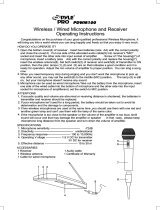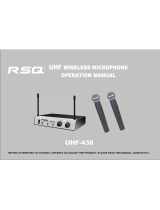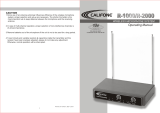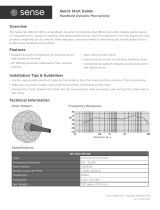5
System Operation
Turn down the AF Level of the receiver as well as the mixer.
Switch on the receiver. Do
not
switch on the transmitter yet.
Receiver On…
The power indicator will light up and one of the tuner operation
indicator LEDs (A or B) will light, even though the transmitter is
not on. If any of the RF LEDs light up at this point, there may be
RF interference in the area. If this occurs, select another fre-
quency using the front-panel channel selectors. The channel dis-
play numbers will begin to flash alternately while changing chan-
nels. Once the desired numbers are displayed, press the “Set”
button to engage the channel.
Transmitter On…
Before turning on the transmitter, use the provided screwdriver
to set the transmitter channel selector switches (Fig. D/F) to the
same numbers as those displayed on the receiver. The transmit-
ter channel selector switch marked “X10” corresponds to the
receiver‘s left-column channel display number, and the selector
switch marked “X1” corresponds to the receiver‘s right-column
channel display number. Always turn the transmitter off when
changing frequencies.
When the transmitter is switched on and in normal operation,
the receiver’s RF signal level indicators will light up from left to
right. For optimum performance at least four, and preferably five,
of the signal strength indicators should light up when the trans-
mitter is switched on. The transmitters have a three-position
power switch. When the switch is set to “Standby,” the trans-
mitter produces RF with no audio signal. When the switch is
“On,” the transmitter produces both RF and audio.
Setting Levels
Correct adjustment of transmitter audio input, receiver audio out-
put, and mixer/amplifier input and output levels is important for
optimum system performance.
• ATW-T73 and ATW-T76 Handheld Transmitters
The 7000 Series handheld transmitters have factory pre-set
audio input levels.
1. Set the receiver’s AF Level control to “0.”
2. Turn the transmitter on and power up the system.
3. Turn down the mixer’s input trim control (if provided) on
the selected channel; make an initial adjustment of the mixer
channel and output level controls that will allow audio through
the system.
4. While speaking/singing into the microphone at typically-loud
levels, adjust the mixer’s input trim control so the highest sound
pressure level going into the microphone causes no input over-
load in the mixer, and yet permits the mixer’s level controls to
operate in their “normal” range (not set too high or too low).
NOTE:
With the receiver’s AF Level set at “0,” its balanced out-
put voltage will be similar to that of a typical wired microphone.
However, the AF Level may need to be adjusted to accommo-
date some microphone inputs.
• ATW-T75 UniPak Transmitter
Trimmer adjustments in the UniPak transmitter (Fig. D) will
enable you to use microphones or instruments with different
output levels.
1. Set both the transmitter Mic Level (MT) and Guitar Level (GT)
controls to their full counter-clockwise position (minimum). (The
level control not being used should be set to minimum.)
2. Set the receiver’s AF Level control to “0.”
3. Plug the mic or instrument into the transmitter and power up
the system.
4.
For MIC:
Make an initial adjustment of the mixer’s level
controls that will allow audio through the system as you increase
the transmitter’s Mic Level.
For INSTRUMENT:
Make an initial adjustment of the instru-
ment amplifier input level control that will allow audio through
the system as you increase the transmitter’s Guitar Level.
5.
For MIC:
While speaking/singing into the microphone at typi-
cally-loud levels, turn up the transmitter’s Mic Level (MT) control
until the maximum audio output of the mic lights about three or
four green LED segments on the receiver’s AF Level indicator.
For INSTRUMENT:
While playing the instrument at typically-
loud levels, turn up the transmitter’s Guitar Level (GT) control
until the maximum audio output of the instrument lights about
three or four green LED segments on the receiver’s AF Level
indicator.
NOTE:
Do not set the transmitter level too high (as indicated
by lighting of the red LED) – doing so will cause the system to
overload and distort.
6.
For MIC:
Next, while again speaking/singing into the
microphone at typically-loud levels, adjust the mixer’s input trim
control so the highest sound pressure level going into the micro-
phone causes no input overload in the mixer, and yet permits
the mixer’s channel and output level controls to operate in their
“normal” range (not set too high or too low).
NOTE:
With the receiver’s AF Level control set at “0,” the
balanced output voltage will be similar to that of a typical wired
microphone. However, the AF Level control may be adjusted
to accommodate some microphone inputs – for example, those
with limited-range or no input trim controls.
For INSTRUMENT:
Next, while again playing the instrument
at typically-loud levels, adjust the receiver’s AF Level control so
the highest signal level causes no input overload in the instru-
ment amplifier, and yet permits the amplifier’s input level
controls to operate in their “normal” range (not set too high
or too low).
NOTE:
With some instrument amplifiers, the receiver’s AF Level
control may need to be adjusted to between “0” and “+6” to
better drive the amplifier.
CAUTION! The small trimmer controls are
delicate
; use only a
small screwdriver or alignment tool with a maximum
3
/
32
"-wide
blade. Do
not
force the trimmers beyond their normal 260°
range of rotation.
Receiver Squelch
The squelch control on the back panel of the receiver is preset
at the factory, but can be adjusted if you must use the system
in an area with considerable RF interference. If there is
interference in the audio, and changing the channel is not an
option, adjust the squelch control so the system will receive the
signal from
your
transmitter but will “squelch” or eliminate the
unwanted background RF noise. This adjustment can cause a
reduction in useable range of the wireless transmitter, so set the
control to the
lowest
position that reliably mutes the unwanted
RF signals.
RF Interference
Please note that wireless frequencies are shared with
other radio services. According to Federal Communications
Commission regulations, “Wireless microphone operations
are unprotected from interference from other licensed
operations in the band. If any interference is received by
any Government or non-Government operation, the wireless
microphone must cease operation...”
If you need assistance with operation or frequency selection,
please contact your dealer or the Audio-Technica professional
division. Extensive wireless information also is available on the
Audio-Technica Web site at www.audio-technica.com.











